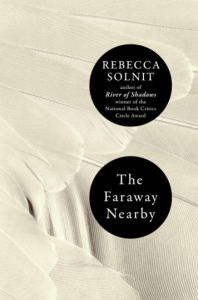Writers Read: The Faraway Nearby by Rebecca Solnit
 Rebecca Solnit gets the title for her work The Faraway Nearby from Georgia O’Keefe. “From the faraway nearby” was how O’Keefe would sign letters to the people she loved after moving from New York City to rural New Mexico. Says Solnit, “It was a way to measure physical and psychic geography together” (108). It is in this way that the author takes us on a journey through her own life along with the lives of a number of historic figures, literary and otherwise. The Faraway Nearby is memoir meets history lesson meets philosophical musings. It’s as much about Solnit’s relationship with her mother and the impact that Alzheimer’s has on them as it is about the craft of writing and the role storytelling plays in all of our lives. On the surface, this is a book about family dynamics, a trip to Iceland, mental and physical health problems, and the dilemma of dealing with three big boxes of apricots. That said, this is not a book that allows the reader to remain on the surface.
Rebecca Solnit gets the title for her work The Faraway Nearby from Georgia O’Keefe. “From the faraway nearby” was how O’Keefe would sign letters to the people she loved after moving from New York City to rural New Mexico. Says Solnit, “It was a way to measure physical and psychic geography together” (108). It is in this way that the author takes us on a journey through her own life along with the lives of a number of historic figures, literary and otherwise. The Faraway Nearby is memoir meets history lesson meets philosophical musings. It’s as much about Solnit’s relationship with her mother and the impact that Alzheimer’s has on them as it is about the craft of writing and the role storytelling plays in all of our lives. On the surface, this is a book about family dynamics, a trip to Iceland, mental and physical health problems, and the dilemma of dealing with three big boxes of apricots. That said, this is not a book that allows the reader to remain on the surface.
“What’s your story?” asks Solnit. She not only poses the question throughout the book, but also chooses this as the narrative’s opening thought. She quickly establishes that stories “are geography, and empathy is first of all an act of imagination, a storyteller’s art, and then a way of traveling from here to there” (3). She then deepens our understanding of how empathy connects with the book’s overarching theme of searching and journeying by bringing us back to this idea periodically, including toward the book’s concluding pages, in which she states, “Empathy means that you travel out of yourself a little or expand” (194). Solnit allows us to travel and expand in this way as a result of what she has to say and also because of how she has opted to say it. The Faraway Nearby begins and ends with “Apricots,” not only as a story element, but also as a chapter title. In fact, the structure of the book is such that the thirteen chapter titles reverse and repeat after reaching “Wound,” “Knot,” and “Unwound”—the sixth, seventh and eighth.
On the surface, this is a book about family dynamics, a trip to Iceland, mental and physical health problems, and the dilemma of dealing with three big boxes of apricots. That said, this is not a book that allows the reader to remain on the surface.
The book jacket refers to the work as “a marvelous Russian doll of a book in which stories contain stories and chapters mirror themselves,” and this Russian doll analogy is contained within. “I am, we each are, the inmost of a series of Russian dolls,” writes Solnit, adding, “you who read are now encased within a layer I built for you, or perhaps my stories are now inside you.” While this imagery is certainly relevant to the experience of reading Solnit’s work, it is the ways in which the narrator describes a labyrinth that captures this work most powerfully and provocatively. “A maze is a conversation; a labyrinth is an incantation or perhaps a prayer,” says one passage. “It’s not ultimately a journey of immersion but emergence” (188). Additionally, a description that associates labyrinths with “a spool of thread and the words and lines and pages of a book” acts like a mirror used to reflect the book’s own structure and spirit (189). This is not only a product of the previously mentioned repeating and reversing chapter titles, but also the result of a second story line—literally a line—that appears on the bottom of every page. From its enigmatic opening statement, “Moths drink the tears of sleeping birds” to its concluding question, “Who hears your story?,” the spool of thread-like story unfolds page by page and requires a constant emergence from the primary story in order to follow along. That is, of course, unless one were to read the two stories separately, finishing one before starting on the other.

Rebecca Solnit. Photo by Sallie Dean Shatz. Courtesy of Viking Books.
The Faraway Nearby is a compelling example of how simple, seemingly contained personal stories can become expansive and universal. “My own story in its particulars hardly interests me now,” says Solnit, soon after she proclaims that “writing is saying to no one and to everyone the things it is not possible to say to someone” (65, 64). In doing so, the narrator underscores the responsibility of those who travel into creative nonfiction territory, a responsibility that includes having “an intimacy with the faraway and distance from the near at hand” (65).
Solnit, Rebecca. The Faraway Nearby. Viking Adult, 2013. Print.






